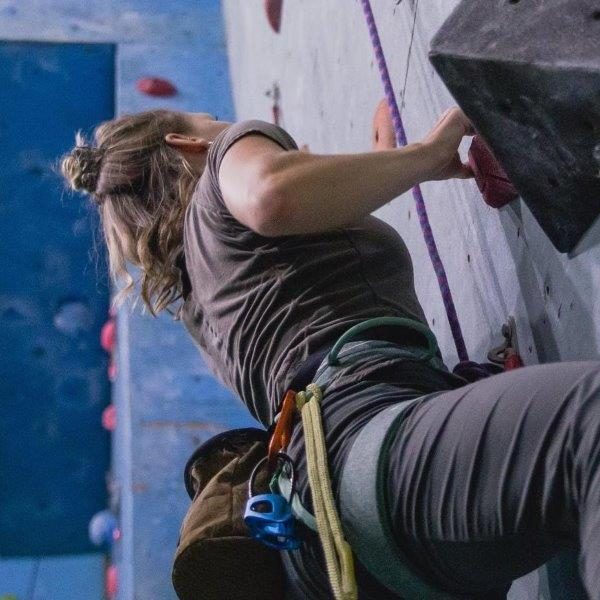Introduction: Embracing the Vertical Challenge
Rock wall climbing offers an exhilarating blend of physical challenge and mental strategy. This dynamic sport attracts thrill-seekers and fitness enthusiasts alike, providing a unique way to build strength, improve flexibility, and boost confidence. Indoor climbing walls have made this adventure sport accessible to people of all ages and skill levels, bringing the excitement of scaling vertical surfaces into urban environments. The sport combines elements of problem-solving, physical endurance, and technical skill, making it a holistic workout for both body and mind.
Climbers develop a keen sense of body awareness and learn to trust their abilities as they navigate complex routes. Moreover, the climbing community fosters a supportive atmosphere, encouraging climbers to push their limits and achieve new heights. Whether tackling a beginner-friendly wall or attempting advanced bouldering problems, rock wall climbing offers a rewarding experience for everyone. As the sport continues to grow in popularity, more people are discovering the joy of conquering vertical challenges and the sense of accomplishment that comes with reaching the top.

The Basics: Understanding Rock Wall Climbing Terminology
Before ascending the wall, climbers must familiarize themselves with essential terminology. “Routes” refer to the specific paths climbers follow, marked by colored holds or tape. “Grades” indicate the difficulty level of a route, using systems like the Yosemite Decimal System (YDS) for roped climbs or the V-Scale for bouldering. “Holds” are the artificial rocks or grips attached to the wall, coming in various shapes and sizes to mimic natural rock formations. “Belaying” involves the use of ropes and harnesses to protect climbers from falls, with the belayer managing the rope from the ground.
“Bouldering” refers to climbing without ropes on shorter walls, typically with crash pads for safety. “Lead climbing” involves clipping the rope into protection points while ascending, offering a more challenging experience. Additionally, climbers use terms like “crimp” (gripping a small hold with fingertips), “jug” (a large, easy-to-grip hold), and “dyno” (a dynamic jump to reach a distant hold). Understanding these terms helps newcomers communicate effectively with fellow climbers and instructors, enhancing the learning experience and safety on the wall.
Essential Gear: Equipping Yourself for the Climb
Proper equipment ensures safety and comfort during rock wall climbing sessions. The most crucial piece of gear is a well-fitting harness, which distributes weight evenly and connects the climber to the rope system. Climbing shoes, designed with sticky rubber soles, provide excellent grip on small holds and help climbers maintain precise foot placement. A chalk bag, worn around the waist, holds powdered chalk to keep hands dry and improve grip. For roped climbing, a belay device is essential, allowing the belayer to control the rope and catch falls.
Carabiners, strong metal loops with spring-loaded gates, connect various parts of the climbing system. Helmets, while not always required for indoor climbing, are crucial for outdoor routes to protect against falling debris. Additionally, climbers should invest in comfortable, breathable clothing that allows for a full range of motion. As skills advance, climbers may add items like quickdraws (for lead climbing) or crash pads (for bouldering) to their gear collection. Regularly inspecting and maintaining equipment is vital for ensuring safety on the wall.

Climbing Techniques: Mastering the Art of Vertical Movement
Efficient climbing techniques form the foundation of successful ascents. The fundamental principle of climbing involves using legs for power and arms for balance and positioning. This approach conserves energy and allows for longer, more challenging climbs. Footwork plays a crucial role, with climbers learning to place their feet precisely on holds and use different parts of their shoes for various techniques. “Edging” involves using the inside or outside edge of the shoe on small holds, while “smearing” uses friction to stick to flat surfaces. Hand techniques include the crimp grip for small holds, the pinch for protruding features, and the sloper grip for rounded holds.
Body positioning is equally important, with climbers learning to keep their hips close to the wall and use “flagging” (extending a leg for balance) to maintain stability. “Drop knees” and “heel hooks” are advanced techniques that help climbers navigate overhangs and difficult sequences. Additionally, climbers develop dynamic movement skills, learning to “deadpoint” (control momentum to reach a hold) and execute powerful dynos when necessary. Mastering these techniques requires practice and patience, but they ultimately allow climbers to tackle increasingly challenging routes with grace and efficiency.
Route Reading: Deciphering the Vertical Puzzle
Successful climbing relies heavily on the ability to read routes effectively. Before attempting a climb, experienced climbers take time to analyze the route from the ground, identifying key holds, potential rest spots, and crux sections (the most challenging parts of the route). This process, known as “beta,” helps climbers develop a mental map of their ascent. Route reading involves identifying the most efficient path up the wall, considering factors like hold types, body positioning, and potential sequences of moves. Climbers look for features like “jugs” for resting, “crimps” for technical sections, and “slopers” that may require specific body positions to utilize effectively.
Additionally, they consider the overall flow of the route, looking for opportunities to conserve energy and maintain momentum. As climbers progress, they develop the ability to read routes on the fly, adapting their strategy as they encounter unexpected challenges or discover better sequences. This skill combines visual analysis, spatial awareness, and problem-solving abilities, making route reading a mental workout that complements the physical aspects of climbing.

Training and Conditioning: Building Strength and Endurance
Rock wall climbing demands a unique combination of strength, flexibility, and endurance. Effective training programs target these specific needs to improve climbing performance. Finger strength is crucial for gripping small holds, and climbers often use hangboards or campus boards to develop this specialized strength. Core exercises like planks and leg lifts enhance body control and stability on the wall. Pull-ups and rows build upper body strength, while squats and lunges develop leg power for pushing upward. Flexibility training, including yoga or dedicated stretching routines, improves range of motion and helps climbers contort their bodies into challenging positions.
Endurance training involves climbing longer routes or doing laps on shorter ones to build stamina. Many climbers incorporate cardiovascular exercise like running or cycling to improve overall fitness. Additionally, antagonist training (exercises that work opposing muscle groups) helps prevent imbalances and reduce the risk of injury. As climbers advance, they may incorporate more specialized training techniques like system boards or moonboards to target specific weaknesses. Consistent, well-rounded training not only improves climbing performance but also reduces the risk of injury and enhances overall fitness.
Safety First: Understanding and Implementing Climbing Protocols
Safety forms the cornerstone of rock wall climbing, with strict protocols and practices designed to minimize risks. Proper belaying technique is essential, involving clear communication between climber and belayer using standardized commands like “On belay,” “Climbing,” and “Take.” Climbers must learn to tie in correctly using a figure-eight follow-through knot, while belayers master the use of belay devices and brake hand positions. Regular equipment checks before each climb ensure that harnesses, ropes, and carabiners are in good condition and properly secured. In bouldering areas, spotters help guide falling climbers onto crash pads, reducing the risk of injury.
Climbers also learn to fall safely, keeping their bodies relaxed and ready to absorb impact. Additionally, understanding and respecting climbing gym rules, such as not climbing above or below other climbers, helps maintain a safe environment for everyone. For outdoor climbing, additional safety considerations include assessing weather conditions, checking rock quality, and being prepared for emergencies with first aid kits and communication devices. By prioritizing safety and following established protocols, climbers can enjoy the thrill of the sport while minimizing risks.
Mental Game: Overcoming Fear and Building Confidence
The psychological aspects of rock wall climbing play a significant role in a climber’s success and enjoyment of the sport. Fear of falling, height anxiety, and self-doubt can present substantial mental barriers. Overcoming these challenges requires a combination of techniques and mindset shifts. Gradual exposure to height and controlled falling practice help climbers become more comfortable with the inherent risks of the sport. Visualization techniques, where climbers mentally rehearse routes and successful ascents, can boost confidence and improve performance. Mindfulness and breathing exercises help manage anxiety and maintain focus during challenging climbs.
Setting realistic goals and celebrating small victories builds a sense of progress and accomplishment. The climbing community often provides a supportive environment, with encouragement and shared experiences helping newcomers push through mental blocks. As climbers gain experience, they develop a more nuanced risk assessment ability, learning to distinguish between healthy caution and irrational fear. This mental resilience not only enhances climbing performance but often translates to increased confidence in other areas of life. By embracing the mental challenges of climbing, practitioners develop valuable skills in problem-solving, self-reliance, and emotional regulation.

Indoor vs. Outdoor Climbing: Bridging the Gap
While indoor rock walls provide a controlled and accessible environment for learning and practice, many climbers aspire to tackle outdoor routes. The transition from indoor to outdoor climbing presents new challenges and rewards. Indoor climbing offers consistent conditions, clearly marked routes, and readily available safety systems. In contrast, outdoor climbing requires additional skills such as route finding, weather assessment, and natural protection placement. The texture and features of natural rock differ significantly from artificial holds, demanding adjustments in technique and body positioning. Outdoor climbers must also consider environmental factors, including sun exposure, wind, and potential hazards like loose rocks.
However, the rewards of outdoor climbing, including breathtaking views, connection with nature, and a sense of adventure, motivate many to make the transition. Many climbers maintain a balance between indoor and outdoor climbing, using gym sessions for training and skill development while applying those skills to natural rock formations. Climbing gyms often offer outdoor clinics or guided trips to help indoor climbers bridge the gap safely. As climbers gain experience in both environments, they develop a well-rounded skill set that enhances their overall climbing ability and enjoyment of the sport.
The Climbing Community: Embracing a Supportive Culture
One of the most appealing aspects of rock wall climbing extends beyond the physical challenge – the vibrant and supportive community that surrounds the sport. Climbing gyms and crags often become social hubs where people of diverse backgrounds unite over a shared passion. This community aspect fosters a unique culture of encouragement, knowledge sharing, and mutual support. Experienced climbers readily offer advice and “beta” to newcomers, creating an inclusive atmosphere that welcomes climbers of all levels. Many gyms organize social events, competitions, and clinics that strengthen community bonds and provide opportunities for skill development.
The collaborative nature of problem-solving in bouldering and the trust required in roped climbing naturally build strong connections between climbing partners. Additionally, the climbing community often extends its ethos of support to environmental and social causes, with many climbers actively involved in conservation efforts and access initiatives. Online forums and social media groups further expand the reach of the climbing community, allowing climbers to connect, share experiences, and organize meetups across geographical boundaries. This strong sense of community not only enhances the enjoyment of the sport but also provides a support network that extends far beyond the walls and cliffs.
Conclusion: Scaling New Heights in Life and Sport
Rock wall climbing offers more than just a physical workout; it provides a transformative experience that challenges individuals to push their limits, overcome fears, and achieve personal growth. The sport combines physical strength, mental strategy, and problem-solving skills in a unique way that keeps participants engaged and constantly striving for improvement. As climbers progress from their first tentative steps on a beginner wall to tackling advanced routes and outdoor challenges. They develop not only climbing-specific skills but also valuable life skills such as perseverance, risk assessment, and self-reliance.
The supportive climbing community provides a positive environment for personal development and social connection. Whether pursued as a serious athletic endeavor or a recreational activity, rock wall climbing offers something for everyone. Its accessibility through indoor gyms has opened the sport to a wide audience, while the allure of outdoor climbing continues to inspire adventure and exploration. As the sport continues to grow and evolve, it promises to offer new challenges, technologies, and opportunities for climbers to test their limits and experience the unique thrill of vertical ascent. For those willing to take that first step onto the wall, rock climbing offers a journey of continuous discovery, both of the world around them and their own potential.


